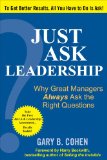Leadership Inspirations – Personal Limitations

Richard Gaylord Briley
Author

Richard Gaylord Briley
Author
We’ve all been there. You walk into a bank, restaurant or store and suddenly feel it, that vague sensation that all is not well. It drips from the ceilings and sits in puddles on the floor. The employees are lost in thought, unable to decide whether they’d rather be somewhere else or stay and kill each other. And you’re the lucky one bathing in all the poison they can ladle up.
Yeesh.
I hope you’ve experienced the other side, too. You walk in the door and are gobsmacked by a sense of well-being. This isn’t just a place where people work, it’s a place that WORKS. The employees want to be there and they want YOU to be there. You feel your brow relax, and the corners of your mouth head ever-so-slightly north. You don’t wanna leave.
So which of these do YOU work in?
Hi there! This article is available for free. Login or register as a StrategyDriven Personal Business Advisor Self-Guided Client by:
Subscribing to the Self Guided Program - It's Free!
About the Author

is a New York Times, Wall Street Journal and #1 Amazon bestseller. Roxanne is renowned for her ability to transform “ho-hum” workplaces into dynamic, results-oriented, “bring-it-on” cultures in a day. Listen to the free 60-second audio with teammates each Monday to clean up the craziness in your workplace and focus on getting massive results. Sign up today at www.ThankGoditsMonday.com.

Jacqueline Kennedy Onassis
First Lady of the United States (1961 – 1963)

Special Edition 20b – An Interview with Gary Cohen, author of Just Ask Leadership, part 2 of 2 explores how leaders can enhance their organization’s alignment and accountability through question-based leadership. During our discussion, Gary Cohen, Partner and co-Founder of CO2 Partners and author of Just Ask Leadership: Why Great Managers Always Ask the Right Questions shares his insights regarding:

Additional Information
In addition to the invaluable insights Gary shares in Just Ask Leadership and this special edition podcast are the additional resources accessible from his Just Ask Leadership website (www.JustAskLeadership.com) and the CO2 Partners website (www.CO2Partners.com). The values assessment discussed during the podcast can be accessed at www.CEOTest.com. Gary’s book, Just Ask Leadership
, can be purchased by clicking here
.
Final Request…
The strength of our community grows with the additional insights brought by our expanding member base. Please consider rating us on iTunes by clicking here. Rating the StrategyDriven Podcast and providing your comments online improves our ranking and helps us attract new listeners which, in turn, helps us grow our community.
Thank you again for listening to the StrategyDriven Podcast!
About the Author

, is Partner and co-Founder of CO2 Partners, a Minneapolis based executive coaching and consulting firm. Gary is renowned for his work as the President and co-Founder of ACI Telecentrics, a company he took from 2 to 2,200 employees and a peak of $32 million in annual revenues. Under his leadership, ACI grew at an average compounded rate of over 50 percent for almost 13 years and was recognized as one of Venture Magazine’s Top 10 Best Performance Businesses and Business Journal’s 25 Fastest Growth Small Public Companies. Gary is frequently interviewed on leadership issues by many of today’s leading publications including USA Today, the Washington Post, and Business Week. To read Gary’s full biography, click here.
Podcast: Play in new window | Download (Duration: 30:37 — 42.1MB)
Subscribe: RSS
Sales leaders are realizing that the single-handed gunslinger approach no longer wins in today’s sales world. Today’s economy demands that you leverage all of your available sales talent by helping your sales reps both farm and hunt productively. Register to Attend this Webinar.
You will learn how to:
Day: Thursday, September 24
Time: 1:00 PM – 2:00 PM EDT
About the Webinar Leader

, is Chairman and Founder of The Sales Board, a Minneapolis-based strategic sales training company that has trained and certified more than 350,000 salespeople in more than 3,000 groups in the system and skills of Action Selling. He has written five sales books, personally facilitated more than 300 Action Selling training sessions and continues to engage in the business and art of the strategic sales process. To read Duanes’s full biography, click here.
